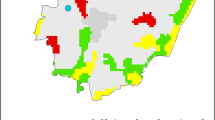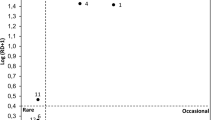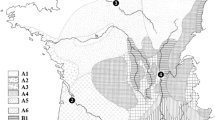Abstract
Little research has been carried out in London concerning fungal spore prevalence yet this information may help to elucidate geographical patterns of asthma and hay fever. Although many types of spore reach peak concentrations outdoors in late-summer, the incidences in the indoor environment may be more important through the winter because of heating and poor ventilation. Daily average concentrations of fungal spores in the ambient atmosphere were monitored with a Burkard volumetric spore trap on an exposed roof in North London from autumn 1991 until the summer of 1992. Indoor spore measurements were taken in 19 homes in the vicinity through the winter months, both by direct air sampling using a portable Burkard sampler and by dust culture. Trends in the occurrence and concentrations of fungal spores indoors and outdoors were examined. Relationships between the abundance of selected allergenic fungi and features of the houses were analysed including age of dwelling, dampness, cleanliness and presence of pets.Aspergillus andPenicillium were the most frequently occurring spore types in the homes. Overall, high spore incidence was associated with dampness and dust accumulation. The outdoor spore samples revealed generally low concentrations through the winter until March when concentrations of many types includingCladosporium, Epicoccum andAlternaria increased in abundance in response to the warmer weather. Even during the late-spring and early-summer, concentrations of most fungal spores were notably below those reported for rural sites.
Similar content being viewed by others
References
Åberg, N. (1989) Asthma and allergic rhinitis in Swedish conscripts. Clin. Exp. Allergy 19, 59–63.
Andersen, A. (1985) Micro fungi in beds and their relation to house dust mites. Grana 24, 55–59.
Gravesen, S. (1972) Identification and quantitation of indoor airborne micro-fungi during 12 months from 44 Danish homes. Acta Allergol. 27, 337–354.
Gravesen, S. (1978) Identification and prevalence of culturable mesophilic micro-fungi in house dust from 100 Danish homes — a comparison between airborne and dust bound fungi. Allergy 35.
Gravesen, S. (1986) Demonstration of micro-organisms and dust in schools and offices. Allergy 41, 520–525.
Lacey, J. (1991) Aerobiology and health: the role of fungal spores in respiratory disease. In: D. Hanhwarth (Ed.), Frontiers in Mycology. Honorary and general lecture from the 4th Mycological Congress, Regensbury, Germany, 1990, pp. 157–185.
Lumpkins, E.D., Corbit, S.L. and Tiedeman, G.M. (1973) Airborne fungi survey culture-plate survey of the home environment. Ann. Allergy 31, 40–44.
Lustgraaf, B.V.D. and Bronswijk, J.E.M.H. (1977) Fungi living in house dust. Ann. Allergy 39, 152.
Palmas, F. and Cosentino, S. (1990) Comparison between fungi airspore concentration at 2 Different Sites in the South of Sardinia. Grana 29, 87–95.
Platt, D., Martin, C., Hunt, S. and Lewis, C. (1989) Damp housing, mould growth and symptomatic health state. Br. Med. J. 298, 1673–1678.
Salvaggio, J. and Aukrust, L. (1981) Mould induced asthma. J. Allergy Clin. Immunol. 68(5), 327–346.
Santra, S. and Chanda, S. (1989) Airborne fungal flora in indoor environments of the Calcutta metropolis. Grana 28(2).
Solomon, W. (1976) A volumetric study of winter fungus prevalence in the air of midwestern homes. J. Allergy Clin. Immunol. 57(i), 46–55.
Strachan, D.P. (1988) Damp housing and childhood asthma: validation of reporting of symptoms. Br. Med. J. 297, 1223–1226.
Szantho, A., Osvath, P., Harvath Z., Novak, E. and Kujalek, E. (1992) J. Invest. Allergol. Clin. Immunol 2(2), 84–90.
Tunon-De-Lara, J.M., Tessier, J.J., Lafond-Grallety, J., Domblides, P., Mary, J., Faugere, J.G. and Tayrard, A. (1990) Indoor moulds in asthmatic patients’ homes. Aerobiologia 6.
Waegemaker, M., Van Wageningen, Brunekreef, B. and Boleij, J. (1989) Respiratory symptoms in damp house. Allergy 44, 192–198.
Weeke, E.R. (1989) Pollen allergy and atmospheric pollution: appropiate monitoring technology and clinical significance. Allergologie. Jahrgang 12, Kongrebaugabe, Sept., 5, 59–62.
Author information
Authors and Affiliations
Rights and permissions
About this article
Cite this article
Emberlin, J., Newman, T. & Bryant, R. The incidence of fungal spores in the ambient air and inside homes: Evidence from London. Aerobiologia 11, 253–258 (1995). https://doi.org/10.1007/BF02447205
Received:
Revised:
Accepted:
Issue Date:
DOI: https://doi.org/10.1007/BF02447205




